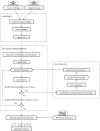Interactive biomedical ontology matching
- PMID: 30995257
- PMCID: PMC6469807
- DOI: 10.1371/journal.pone.0215147
Interactive biomedical ontology matching
Abstract
Due to continuous evolution of biomedical data, biomedical ontologies are becoming larger and more complex, which leads to the existence of many overlapping information. To support semantic inter-operability between ontology-based biomedical systems, it is necessary to identify the correspondences between these information, which is commonly known as biomedical ontology matching. However, it is a challenge to match biomedical ontologies, which dues to: (1) biomedical ontologies often possess tens of thousands of entities, (2) biomedical terminologies are complex and ambiguous. To efficiently match biomedical ontologies, in this paper, an interactive biomedical ontology matching approach is proposed, which utilizes the Evolutionary Algorithm (EA) to implement the automatic matching process, and gets a user involved in the evolving process to improve the matching efficiency. In particular, we propose an Evolutionary Tabu Search (ETS) algorithm, which can improve EA's performance by introducing the tabu search algorithm as a local search strategy into the evolving process. On this basis, we further make the ETS-based ontology matching technique cooperate with the user in a reasonable amount of time to efficiently create high quality alignments, and make use of EA's survival of the fittest to eliminate the wrong correspondences brought by erroneous user validations. The experiment is conducted on the Anatomy track and Large Biomedic track that are provided by the Ontology Alignment Evaluation Initiative (OAEI), and the experimental results show that our approach is able to efficiently exploit the user intervention to improve its non-interactive version, and the performance of our approach outperforms the state-of-the-art semi-automatic ontology matching systems.
Conflict of interest statement
The authors have declared that no competing interests exist.
Figures
Similar articles
-
Using Compact Coevolutionary Algorithm for Matching Biomedical Ontologies.Comput Intell Neurosci. 2018 Oct 8;2018:2309587. doi: 10.1155/2018/2309587. eCollection 2018. Comput Intell Neurosci. 2018. PMID: 30405706 Free PMC article.
-
Towards automated biomedical ontology harmonization.Stud Health Technol Inform. 2014;200:62-8. Stud Health Technol Inform. 2014. PMID: 24851964
-
Tackling the challenges of matching biomedical ontologies.J Biomed Semantics. 2018 Jan 15;9(1):4. doi: 10.1186/s13326-017-0170-9. J Biomed Semantics. 2018. PMID: 29335022 Free PMC article.
-
Experiences from the anatomy track in the ontology alignment evaluation initiative.J Biomed Semantics. 2017 Dec 4;8(1):56. doi: 10.1186/s13326-017-0166-5. J Biomed Semantics. 2017. PMID: 29202830 Free PMC article. Review.
-
Assessing the practice of biomedical ontology evaluation: Gaps and opportunities.J Biomed Inform. 2018 Apr;80:1-13. doi: 10.1016/j.jbi.2018.02.010. Epub 2018 Feb 17. J Biomed Inform. 2018. PMID: 29462669 Free PMC article. Review.
Cited by
-
CMAT: ClinVar Mapping and Annotation Toolkit.Bioinform Adv. 2024 Feb 7;4(1):vbae018. doi: 10.1093/bioadv/vbae018. eCollection 2024. Bioinform Adv. 2024. PMID: 38384863 Free PMC article.
References
-
- Golbeck J, Fragoso G, Hartel F, Hendler J, Oberthaler J, Parsia B. The National Cancer Institute’s thesaurus and ontology. Web Semantics: Science, Services and Agents on the World Wide Web. 2011;1(1):1–5.
-
- Schulz S, Cornet R, Spackman K. Consolidating SNOMED CT’s ontological commitment. Applied ontology. 2011;6(1):1–11.
-
- Lopez-Fernandez H, Reboiro-Jato M, Glez-Pena D, Aparicio F, Gachet D, Buenaga M, et al. BioAnnote: A software platform for annotating biomedical documents with application in medical learning environments. Computer methods and programs in biomedicine. 2013;111(1):139–147. 10.1016/j.cmpb.2013.03.007 - DOI - PubMed
Publication types
MeSH terms
LinkOut - more resources
Full Text Sources


